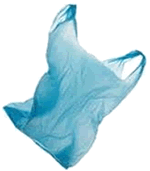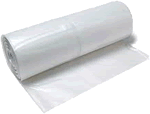3.2.9 Alkenes - Polymerisation of alkenes
Students should:
|
Addition polymers
As explained in the prevgious section, an addition reaction involves two molecules joining together with nothing lost.
Poli = many (Greek), meros = 1 part of a whole (Greek), polymer = large unit made up of many identical small units. Hence addition polymerisation is the process of forming a giant structure from many small structures adding together.
Click on the button below for more information
(poly)ethene
Production of Low Density PolyEthene (LDPE)
 Requires:
Requires:
- temperature range of 100-300ºC
- very high pressure 1500-3000 atmospheres
- oxygen or an organic peroxide such as dibutyl peroxide, benzoyl peroxide or diethyl peroxide as initiator.

An initiator is a substance which is added in small quantities and is decomposed by light or heat to produce a free radical (R•). A free radical is formed when a covalent bond is broken and a bonding electron is left on each part of the broken molecule. Since the O-O covalent bond is weak, free radicals are easily formed from oxygen or peroxides.
Benzene or chlorobenzene is used as the solvent since both polymer (polythene) and monomer (ethene) dissolve in these compounds at the temperature and pressure used. Water or other liquids may be added to dissipate the heat of reaction as the polymerization reaction is highly exothermic.
CH2=CH2 ethene + R•(initiator)
![]() •CH2-CH2-R
•CH2-CH2-R
CH2=CH2 + •CH2-CH2-R
![]() •CH2-CH2-CH2-CH2-R
•CH2-CH2-CH2-CH2-R
Process continues to form polythene (polyethylene) [-CH2-CH2-]n
Production of HDPE
Production of HDPE by addition polymerization with a supported metal oxide catalyst requires:
- temperature ~300ºC
- atmosphere pressure (100.0 kPa)
- aluminium-based metal oxide catalyst (metallocene catalyst)
The catalyst can be used in a variety of operating modes including fixed-bed, moving-bed, fluid-bed or slurry processes
The ethene (ethylene) monomer is fed with a paraffin or cycloparaffin diluent (diluting agent). After polymerization the polymer (polythene) is recovered by cooling or by solvent evaporation.
Production of HDPE by coordination polymerization requires:
- temperature 50-75ºC
- slight pressure
- a coordination catalyst is prepared as a colloidal suspension by reacting an aluminium trialkyl and titanium chloride (TiCl4) in a solvent such as heptane (C7H16).
The polymer (polythene) forms as a powder or granules which are insoluble in the reaction mixture. When the polymerization is completed, the catalyst is destroyed by adding water or alcohol to the reaction mixture. The polymer (polythene) is then filtered or centrifuged off, washed and dried.
Properties
| Property | Low Density Polyethylene (LDPE) |
High Density Polyethylene (HDPE) |
| Melting Point | ~115ºC | ~135ºC |
| Crystallinity | low crystallinity (50-60% crystalline)Main chain contains many side chains of 2-4 carbon atoms leading to irregular packing and low crystallinity (amorphous) | highly crystalline (>90% crystalline) contains less than 1 side chain per 200 carbon atoms in the main chain leading to long linear chains that result in regular packing and high crystallinity |
| Flexibility | more flexible than HDPE due to lower crystallinity | more rigid than LDPE due to higher crystallinity |
| Strength | not as strong as HDPE due to irregular packing of polymer chains | strong as a result of regular packing of polymer chains |
| Heat Resistance | retains toughness & pliabilty over a wide temperature range, but density drops off dramatically above room temperature. | useful above 100ºC |
| Transparency | good transparency since it is more amorphous (has non-crystalline regions) than HDPE | less transparent than LDPE because it is more crystalline |
| Density | 0.91-0.94 g/cm3 lower density than HDPE |
0.95-0.97 g/cm3 higher density than LDPE |
| Chemical Properties | Chemically inert. Not soluble at room temperature in most
solvents. Good resistance to acids and alkalis. Exposure to light and oxygen results in loss of strength and loss of tear resistance. |
|
| Uses | sandwich bags, cling wrap, car covers, squeeze bottles, liners for tanks and ponds, moisture barriers in construction | freezer bags, water pipes, wire and cable insulation, extrusion coating |
(poly)propene
(Poly)propene is linear in structure and its monomer is represented by the formula of CnH2n where n is the number of atoms. Its production cost is not very high. It can be obtained from propene gas using Zeigler-Natta catalysts. (Poly)propene is also obtained as a by-product of the refining process of oil.
Properties
| Property | Character |
| Density | (Poly)propene is a low density material |
| Tensile strength | High tensile strength. Strong resistance towards stress and cracking |
| Structure | Crystalline in nature and possess a regular geometrical shape |
| Insulation | Excellent insulator |
| Moisture Absorption | (Poly)propene does not get affected by moisture |
| Melting Point | 160°C. Unlike other polymers, eg (poly)ethene, (poly)propene retains its properties even at a very high temperature |
| Corrosion | unaffected by chemicals like alkaline substances, acids, de-greasing agents, electrolytic attacks, etc. However, its resistance towards aromatic or aliphatic hydrocarbons, chlorinated solvents and ultraviolet radiation is not very strong. |
| Toxicity | non-poisonous |
 The
different (poly)propene properties and uses makes it a very popular choice for
various industries. (Poly)propene is largely used for manufacturing various
housewares. It is used for making superior quality food containers that can
be safely washed in a dishwasher.
The
different (poly)propene properties and uses makes it a very popular choice for
various industries. (Poly)propene is largely used for manufacturing various
housewares. It is used for making superior quality food containers that can
be safely washed in a dishwasher.
It can also be used for making food cans and syrup bottles that are used for
food packaging of various food contents. As different dyes can be mixed with
(poly)propene, it is used as fibre for making beautiful as well as highly durable
carpets. 
These carpets can be used near swimming pools or other such areas where it is exposed to a lot of water. (Poly)propene, in a highly pure form, is used in semiconductor industry. It does not promote growth of bacteria on its surface and hence it is used in the manufacture of various medical equipments.
Due to the high impact (poly)propene properties, it is often used for making ropes that are required for fishing and agriculture purposes. In the construction sector, (poly)propene is widely used in the manufacture of pumps and different types of pipes.

In automotive sector, (poly)propene is used in making several auto parts like bumpers, battery cases, etc.